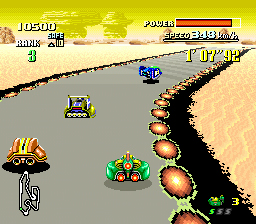With the two-year head start that upstart rival SEGA had on Nintendo with the release of their 16-bit console, the Genesis, Nintendo needed something that would help them even the score when they released the Super Nintendo Entertainment System. Sure, they had more colors and better sound chips to work with, but for that added edge that pushed them that much further, they turned to the hardware feature known as Mode 7.
With Mode 7, developers could not only scale graphics to create zooming effects which could increase or reduce the size of various graphics, such as several of the encounters with Bowser and his Koopalings in the pack-in title Super Mario World, but also rotate them in ways which simulated a 3D field. The original showcases for this particular feat came in the form of fellow launch titles Pilotwings and would-be new mascot series F-Zero, which used the function to turn and twist the background layer beneath the player in such a way that it looked like they were actually skydiving towards an island or racing across a futuristic track high above an underlying city.
It’s this latter implementation which would help give birth to one of Nintendo’s most popular series to date with Super Mario Kart, but it was also a godsend for creators of role playing games that would feature vast overworld maps for the player to traverse. Secret of Mana, Chrono Trigger, and the trio of mainline Final Fantasy games released for the system all put this to good use in their expansive worlds.
As great as it was at the time, however, Mode 7 is not something that was destined to stick around. With Nintendo constantly looking to make further inroads into 3D gaming, they would go on to create chips and eventually full-blown native console hardware that could achieve the same effect through use of polygons and full 3D engines. Even so, Nintendo would go on to replicate the effect through other means with the Game Boy Advance and its many ports of Super NES titles, while SEGA was able to play catch-up to some degree with games released for their SEGA CD and 32X add-ons before the need faded into the pages of history.




